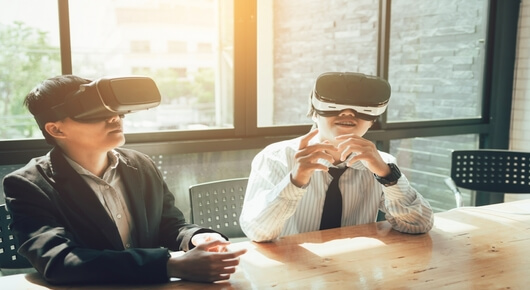
As digital marketing continues to evolve and change, the need to engage customers in unique ways becomes even more vital. While new tools and technology emerge seemingly every day, two trends are commanding the B2B world’s attention: augmented and virtual reality (AR and VR). In fact, according to a report from Statista, the economic impact of AR and VR is forecast to amount to $29.5 billion in 2020.
AR renders the integration of digital content with a user’s environment in real time, typically by adding layers of information onto something. VR, on the other hand, refers to computer-generated environments positioned to simulate an individual’s physical presence in a certain space, usually by way of a headset.
B2B companies such as Showpad, Phononic and TopRank Marketing have begun incorporating AR and/or VR into their marketing strategies to provide customers with creative, cutting-edge avenues for interacting with content.
“[AR and VR] have been hot in the B2C world for some time,” said Theresa O’Neil, CMO at Showpad, in an interview with Demand Gen Report. “…The same trends in B2C migrate to B2B, and in B2B, if you think about the sales, they start to get redundant … So, B2B businesses that can use digital capabilities like augmented [and] virtual reality really have the potential to differentiate against their competitors.”
Creating Interactive Experiences That Show Instead Of Tell
In marketing, presenting a complicated idea solely through words can be challenging, which is why more marketers are leveraging the power of visual communication. In fact, according to Demand Gen Report’s 2019 Content Preferences Survey, 51% of respondents recommend that marketers do not overload their content with copy, while 58% said they are willing to spend five to 20 minutes reviewing interactive content. This signifies that consumers are more interested in entertaining, high-quality content than long, static content.
Using Apple’s ARKit, sales enablement platform Showpad launched an AR featurepositioned to enable customers — many of whom comprise the healthcare and manufacturing industries — to utilize 3D models within Showpad’s iOS application. The tool is intended to help users envision products such as medical devices or pieces of construction machinery within a virtual setting of their customer’s site, whether it be a hospital or a manufacturing plant.
O’Neil said innovations like these not only help consumers visualize products in their natural environment, but they also set companies and salespeople apart from their competition, as they grant consumers a more immersive experience than static content such as paper brochures, PDFs or PowerPoints.
Phononic, a solid-state cooling company, has built AR content to provide customers with a clearer sense of its latest product: a countertop freezer about the size of a car’s glovebox that does not use compressors or produce significant amounts of heat or noise.
Daniel Englebretson, Director of Integrated Marketing at Phononic, said it is difficult for customers to envision the freezer’s size and how much space is inside of it, as well as understand its minimal footprint without seeing it in person.
Looking to target food service equipment workers and category managers at food manufacturing companies, Phononic initially planned to send out a direct mailer of a pop-up cardboard model of the freezer. However, because the cost per piece would limit the number of people receiving the product, Phononic conducted research and found AR to be a more cost-effective strategy.
The company ultimately decided to deploy an app, which will double as an interactive product showcase and sales enablement tool designed to help target account stores “experience” the product in its natural space.
“If you produce an app, you can use it in unlimited places to unlimited people,” said Englebretson, in an interview with Demand Gen Report. “So, the cost per person that’s going to interact with it is substantially lower than basically any other physical medium.”
Incorporating AR/VR Into Event Strategy
Lee Odden, CEO of TopRank Marketing, who has helped to deploy VR content for his clients, echoed a similar sentiment about a VR experience his company created for SAP Ariba.
“From a production standpoint, this is a very substantial investment, and to be able to reuse the environment and simultaneously customize it was very, very important economically,” he said in an interview with Demand Gen Report.
TopRank Marketing’s VR experience for SAP Ariba was built to create engagement with event attendees by allowing them to interact with influencer content through VR goggles. The content illustrates a cityscape scene for conference attendees to walk down several paths. Once an individual reaches a path’s endpoint, they can choose to access insights from industry experts, which can be acquired through text, audio or video, or engage with product content highlighting SAP Ariba’s value propositions.
Similarly, Kaon Interactive, a B2B software company that deploys production-grade AR and VR content, created a visually engaging 3D interactive product catalogue for Cisco that could be brought to trade shows, enabling prospects to virtually interact with or “walk around” each product.
“It’s a digital platform that allowed [Cisco] to tell their product story with respect to each customer’s particular need in a highly engaging way, without having to have the physical products there,” said Gavin Finn, CEO of Kaon Interactive, in an interview with Demand Gen Report.
Finn said the higher engagement from AR and VR content allows B2B companies to reap multiple benefits. For example, Kaon Interactive also created a VR experience for the cloud and security solutions provider CenturyLink to use at AWS re:Invent — a learning conference hosted by Amazon Web Services — and found an increase in qualified lead generation as a result.
CenturyLink aimed to lessen the barriers for its booth staff to engage prospects and have a better interaction with customers once engaged. The VR experience placed users into “recognizable and relatable vignettes and environments that highlight ‘why milliseconds matter’ in those scenarios and why having the right cloud, the right network and the right experts is so important,” according to a case studypublished by Kaon.
Simply put, the content served as a way for the company to tell its story and emphasize the ubiquitous presence of technology in people’s lives. For instance, one scenario featured a point-of-purchase display in a coffee shop with CenturyLink running underground to connect the customer experience points together.
By diminishing the divide between CenturyLink employees and their prospects, the company drove 4.5x the number of leads as the previous year’s AWS re:Invent event, ultimately increasing its financial benefits.
Taking Careful Advantage Of The Growing Need For Unique Content
With copious amounts of content being published every day, B2B companies are looking to distinguish their digital content strategy. But creating highly immersive content requires careful planning.
When conceptualizing a piece of AR or VR content, Finn advises that companies make the experience as realistic and interactive as possible to increase believability and credibility, enhance memory retention, boost consumer engagement and maximize on emotional connection.
While AR and VR technology have an element of “cool” because they are currently not mainstream strategies, solution providers like Kaon Interactive emphasized that they are not just another high-tech solution to add to a technology stack. Both AR and VR require specific expertise to develop and execute successful experiences at scale.
AR and VR are pushing the boundaries of B2B because these technologies can work in conjunction with salespeople — as opposed to replacing them — to bolster a more comprehensive marketing experience.
“Rather than just using something for the glitz factor or for making it sort of an interesting experience that has no real business value, you can now combine that experiential model —whether it’s virtual reality or augmented reality… to be able to deliver the message that needs to get delivered,” said Kaon Interactive’s Finn. “I think [AR and VR] are going to change the way that marketers think about customer engagement going forward — even this year, next year and beyond — because they help us to think about the best ways for the customer to learn about our solution and competitive differentiation.”
Credit to : demandgenreport











